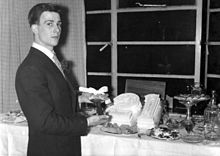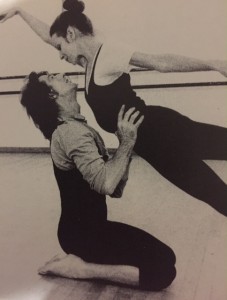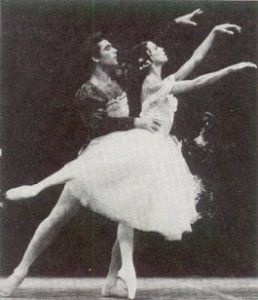
Gary Burne, the famous male ballet dancer was born Algernon De Blois Hayes-Hill in 1932.
Born in Rhodesia, now known as Zimbabwe, the famous male ballet dancer’s journey began at an early age, thanks to his grandmother. It was she who ignited the flame of passion within him, clandestinely whisking him away to Elaine Archibald’s prestigious dance studio when he was a mere seven-year-old.
However, it was not until two years later, when he was summoned to perform in public, that his parents discovered the secret dance lessons. Their reaction was nothing short of a dramatic eruption. Horrified, they proclaimed that dancing would undeniably interfere with their child’s academic pursuits and ultimately unravel his future. They forced him to stop dancing.
A year later he was allowed to return to his ballet lessons as it was obvious that he yearned to dance.
Undeterred by his parents’ vehement objections, the young dancer’s determination only grew stronger. Dancing became his sanctuary, where he unleashed emotions that could not be contained within the mundane confines of textbooks and classrooms.
The intensity of his passion resonated with audiences, as he swiftly rose to prominence within the ballet community. Amidst the chaos and uncertainty, this aspiring artist defied all odds, embracing the drama that life had presented him and transforming it into a mesmerizing symphony on stage.
With each graceful leap and precise pirouette, the ballet prodigy defied societal norms and challenged stereotypes. His every move became a beacon of hope for countless aspiring artists who believed that dreams could transcend beyond societal expectations. And despite the initial resistance from his own family, the tantalizing world of dance opened doors to a future that he could have hardly imagined in his wildest dreams. The stage became his battleground, where his dramatic performances seduced and captivated hearts, solidifying his legacy as one of the world’s most revered male ballet dancers.
Gary was teased mercilessly at school, but he made an effort to excel at school sports. He received tremendous encouragement when Anton Dolin, who was on a tour of Southern Africa, visited Elaine Archibald’s studio in Bulawayo and recommended that Gary further his studies abroad.
Two years later, in 1952, he left for London by boat from Cape Town. Once there, he enrolled in classes with Ruth French and, after three months study with her he went to see Dolin and auditioned successfully for the Sadler’s Wells Ballet School. He changed his stage name to Gary Burne, as his real name was deemed unfit. Only three months later he joined the Royal Ballet and within two years, was promoted to first soloist.
Over the next five years, he danced most of the leading male classical parts scoring successes in Gizelle, Swan Lake, and Sleeping Beauty. He was partnered with famous ballerinas like Nadia Nerina, Merle Park, Antoinette Sibley, Beryl Grey, Svetlana Beriosova, and Margot Fonteyn.
In 1960, Gary Burne visited South Africa and partnered with Nadia Nerina. By now he was a well-established famous male ballet dancer.
In 1962 he joined the Stuttgart State Ballet Company at the invitation of John Cranko and John wrote a ballet for him called Catalyst.
He stayed with the Stuttgart State Ballet Company for eighteen months as a leading male dancer. After suffering a foot injury, he was told by a specialist that he would benefit from living in a warmer climate.
He, therefore, accepted an invitation to join Ballet Transvaal as premier danseur and ballet master, and he danced with Phyllis Spira for the first time at a rehearsal for Swan Lake.
There was an instant rapport between these two dancers and he was amazed that after all the years dancing abroad that he found his ideal partner in Spira.
South African’s imaginations were immediately captured by this startling couple, and they became synonymous with magical, exhilarating, and delightful dancing. They became household names and danced to full houses.
The unique combination of fragility and strength was new and refreshing, and they were often compared with Anton Dolin and Alicia Markova.
In 1964 they joined the CAPAB ballet company in Cape Town and the partnership blossomed. Together they gave South African Ballet the inspiration that it needed.

This famous male ballet dancer was well ahead of his time and loved to experiment with modern choreography using offbeat music. His topics included drugs and sex and Phyllis always danced in his new works as she believed in him.
His first modern ballet was The Misfit which he created in 1967. Then three years later he created The Prodigal Son, which caused a sensation as it was very controversial.
Some of the still photo’s taken of the ballet were banned on grounds of their explicit sexual nature. The ballet premiered in Port Elizabeth in May 1970 to rave reviews, both for Burne’s choreography and for his and Phyllis’s dancing.
Gary was a very controlling partner to Phyllis both onstage and off. He liked to dictate everything that Phyllis could do and often to her detriment. But without a doubt, they were one of the best ballet partnerships ever.
Sadly Gary’s Drug problems eventually got the better of him.
In the ‘Birthday of Infanta’, there were some hairy moments and from 1970 to 1971 he would sometimes come to a performance stoned, and Phyllis was very upset with him and told him if he ever came to do a performance stoned she would never dance with him again. And she never did.
Phyllis only saw Garry one more time in 1974 in Johannesburg, and she didn’t recognize him as his face was bloated, his teeth had fallen out and he had a pot belly.
The story ends sadly for this famous male ballet dancer. In 1975 Gary married ballerina Linda Smit but the marriage lasted only a few months. He committed suicide on the 26th of August 1976. He was only 44 years old.
I was in awe of him while growing up and still think that he was the most amazing and creative person in his field at the time.


I loved reading this story about Gary Burne, he seemed to truly be a force to be reckoned with in the ballet world during his time. However it is very sad that he committed suicide! After 3 years learning ballet, my daughter is showing a serious interest and this is why I started to read more about it and chanced upon your blog. I love to read stories of passionate people in the arts! Can you recommend any good books for ballet dancers in their pre-teens? Thank you for sharing.
Hi Julie, If she is looking to improve her technique, I love The Ballet Companion by Eliza Gaynor Minden. Or you can get a fully Comprehensive Ballet Bible which you can read about here.
Very nice. I like to see Male Ballet Dancers and read about their history’s.
Yes, we always seem to know a lot about the female dancers, as there are many more of them. But there are also a lot of good male dancers and I will do some more posts on some of the more famous ones.
I really enjoyed reading this story. It’s quite bittersweet. It took incredible courage for him to go back to dancing, even after all the teasing and against his parents wishes.
It’s unfortunate that his talent was destroyed by his drug use and suicide. Such an inspiration and such a tragedy in one.
Well done and thank you for sharing.
Yes it is very sad, and it seems to happen to so many famous people. Thanks for the comment Brandy.
This ballet dancer was certainly ahead of his time. It must have been a tough childhood when his peers teased and ridiculed him.
I had never heard Gary Burne before reading this article. It is sad that so many bright and talented people struggle with depression and commit suicide.
Thanks for this thorough article. Are you a ballet dancer yourself?
Used to, but now I teach. Thanks for stopping by Adam.
Gary Burne was my cousin. I would love to know if you have more information on him? Also would love to know information regarding his death as I have his death certificate and it does not mention suicide….
Unfortunately, I could only find limited information on him and most of the information was from other people’s biographies. Interesting to have a talented cousin like this. I watched him once as a child and he was amazing.
The information I found on his death was quoted by others, so I apologise if it is not accurate. Although rarely does it state on a death certificate that cause of death was a suicide.
Thanks for stopping by Brian and great to meet you.
He was Algernon De Blois Hayes-Hill not de Blouis. He was my cousin.
Thanks for that Brian, I will correct that.
Hi. I met Gary in 1974 in port elizabeth. He was staying at the Edward Hotel. As far as I can re collect the newspaper article that mentioned his death did not say suicide.
Yes, that is true, however they don’t always print everything until a lot later. He was an exceptional artist though.